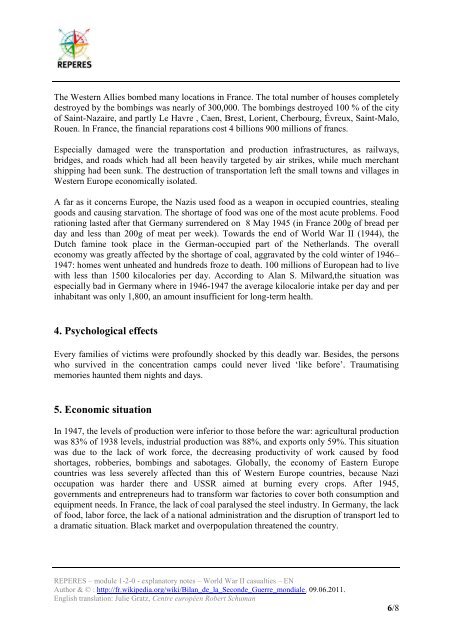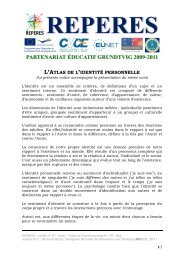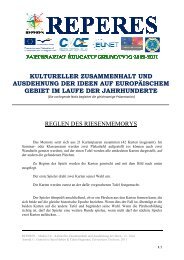World War II casualties - Centre européen Robert Schuman
World War II casualties - Centre européen Robert Schuman
World War II casualties - Centre européen Robert Schuman
Create successful ePaper yourself
Turn your PDF publications into a flip-book with our unique Google optimized e-Paper software.
The Western Allies bombed many locations in France. The total number of houses completely<br />
destroyed by the bombings was nearly of 300,000. The bombings destroyed 100 % of the city<br />
of Saint-Nazaire, and partly Le Havre , Caen, Brest, Lorient, Cherbourg, Évreux, Saint-Malo,<br />
Rouen. In France, the financial reparations cost 4 billions 900 millions of francs.<br />
Especially damaged were the transportation and production infrastructures, as railways,<br />
bridges, and roads which had all been heavily targeted by air strikes, while much merchant<br />
shipping had been sunk. The destruction of transportation left the small towns and villages in<br />
Western Europe economically isolated.<br />
A far as it concerns Europe, the Nazis used food as a weapon in occupied countries, stealing<br />
goods and causing starvation. The shortage of food was one of the most acute problems. Food<br />
rationing lasted after that Germany surrendered on 8 May 1945 (in France 200g of bread per<br />
day and less than 200g of meat per week). Towards the end of <strong>World</strong> <strong>War</strong> <strong>II</strong> (1944), the<br />
Dutch famine took place in the German-occupied part of the Netherlands. The overall<br />
economy was greatly affected by the shortage of coal, aggravated by the cold winter of 1946–<br />
1947: homes went unheated and hundreds froze to death. 100 millions of European had to live<br />
with less than 1500 kilocalories per day. According to Alan S. Milward,the situation was<br />
especially bad in Germany where in 1946-1947 the average kilocalorie intake per day and per<br />
inhabitant was only 1,800, an amount insufficient for long-term health.<br />
4. Psychological effects<br />
Every families of victims were profoundly shocked by this deadly war. Besides, the persons<br />
who survived in the concentration camps could never lived ‘like before’. Traumatising<br />
memories haunted them nights and days.<br />
5. Economic situation<br />
In 1947, the levels of production were inferior to those before the war: agricultural production<br />
was 83% of 1938 levels, industrial production was 88%, and exports only 59%. This situation<br />
was due to the lack of work force, the decreasing productivity of work caused by food<br />
shortages, robberies, bombings and sabotages. Globally, the economy of Eastern Europe<br />
countries was less severely affected than this of Western Europe countries, because Nazi<br />
occupation was harder there and USSR aimed at burning every crops. After 1945,<br />
governments and entrepreneurs had to transform war factories to cover both consumption and<br />
equipment needs. In France, the lack of coal paralysed the steel industry. In Germany, the lack<br />
of food, labor force, the lack of a national administration and the disruption of transport led to<br />
a dramatic situation. Black market and overpopulation threatened the country.<br />
REPERES – module 1-2-0 - explanatory notes – <strong>World</strong> <strong>War</strong> <strong>II</strong> <strong>casualties</strong> – EN<br />
Author & © : http://fr.wikipedia.org/wiki/Bilan_de_la_Seconde_Guerre_mondiale, 09.06.2011.<br />
English translation: Julie Gratz, <strong>Centre</strong> européen <strong>Robert</strong> <strong>Schuman</strong><br />
6/8














